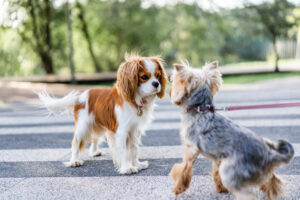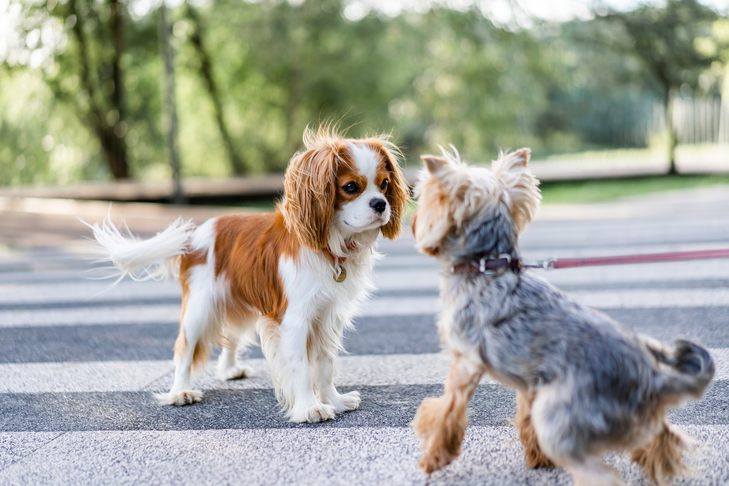
Dogs are social animals, meaning that they are capable of creating and maintaining bonds and relationships with humans and other dogs. Many dogs like meeting and making doggy friends, especially as young puppies. But not all dogs are super social with other dogs, and many dogs do not like to greet strange or unknown dogs, especially when on leash. While we can all recognize that a dog who is growling, lunging, and baring teeth is not cool with an interaction, other body-language signs can be more subtle. So how do you know if two dogs actually want to interact, and whether it’s safe to do so in the first place?
While we strongly recommend against on-leash greetings (read more here if you’re wondering why), we also understand that sometimes they’re inevitable. The key to keeping social interactions between dogs (both on and off-leash) safe, short, and sweet, is to understand dog body language: once you know the green flags and red flags of canine body language, you’ll be better able to assess whether dogs actually want to interact, and if the interactions are good or if they are too tense.
But First: Are They Really ”Saying Hi”?
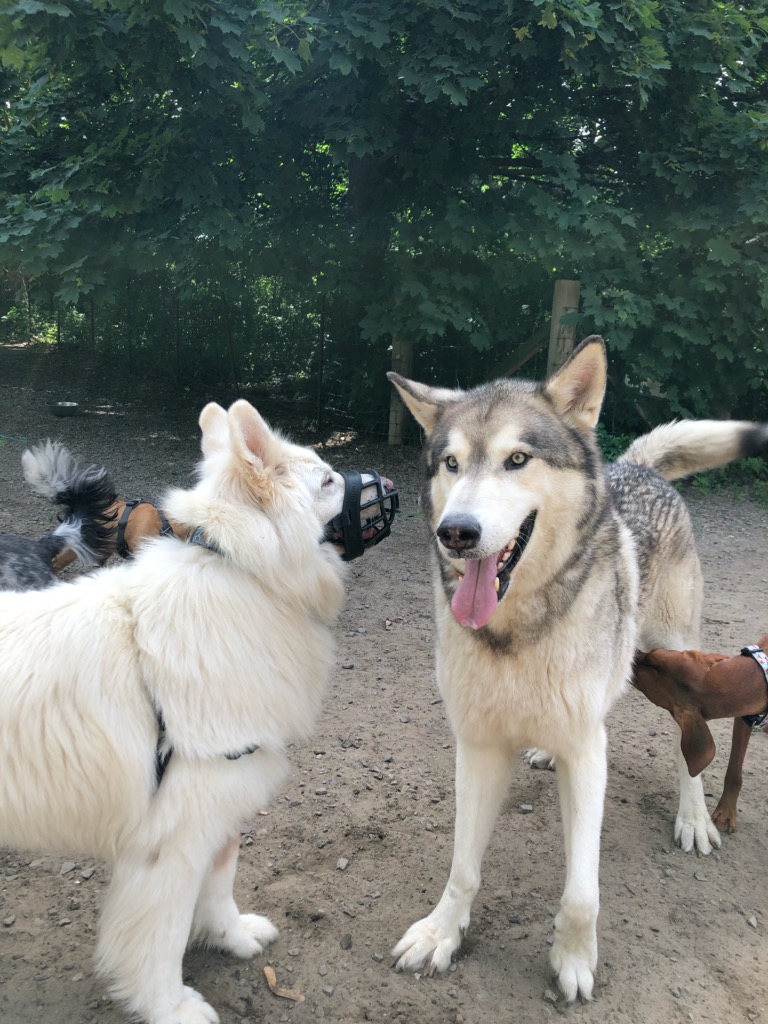
We love to think of dogs greeting each other in human terms: we often assume they are “saying hi to each other” – after all, that’s what humans do when we greet each other! But in Dog World, it’s a little more complicated and greetings actually serve a different purpose. While dogs are social animals and generally understand appropriate versus inappropriate interactions, they don’t exchange pleasantries just for the sake of being friendly. Dogs interact with each other to get information about each other: what we call a “greeting” is actually an in-depth information-gathering session! Think of it like “creeping” a person on social media. (Hey, we all do it!)
Dogs navigate the world primarily through scent- smell is their most powerful and important sense! Sniffing is how they “read” one another. When two dogs meet, they instinctively get up close and personal, sniffing each other’s rear ends to gather essential details—such as health, reproductive status, emotional state, and more. (Fun fact: this is also what dogs are doing when they check out each other’s “pee mail.”) This need for close-range information is one reason why some friendly dogs may display reactive behaviour on-leash or struggle to focus around other dogs: their frustration comes from being unable to approach and gather the details they rely on to feel secure.
Understanding greetings as information-gathering sessions between dogs helps us humans better understand and navigate interactions between dogs because we can understand why those “greetings” are so important in Dog World. This is most clear when you observe the behaviour of free-roaming street dogs: these dogs often approach each other willingly (despite having the freedom to simply keep on going), sniff each other’s hind ends, and then continue on their respective ways. Dogs may want to “greet” each other to feel more safe and secure around each other, but it may not always be safe to do so if one of the dogs is feeling anxious, fearful, or stressed.
The Canine Social Spectrum: Does Your Dog Like Other Dogs?
Understanding how sociable your dog typically is with other dogs will help you navigate canine social interactions. Some dogs love to play with other dogs; some are more selective; some do not enjoy the company of other dogs. As dogs mature from adolescence into adulthood (approximately 2-3 years of age for most dogs), they typically become more selective about who they want to socialize with- this is normal! In fact, there is a canine social spectrum ranging from dog-social (loves most other dogs) to dog-aggressive (not into other dogs)and most adult dogs fall somewhere in the middle (dog-tolerant or dog selective). Where does your dog fit on the social spectrum?
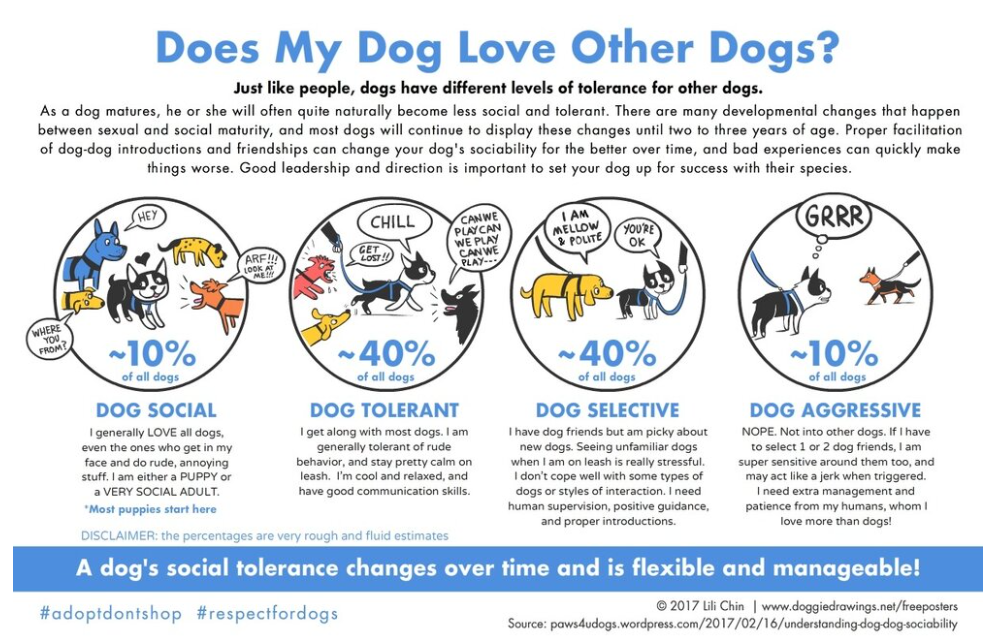
Green Flags During Interactions
Dogs communicate with each other primarily through body language, which means there are signals we can observe which tell us how the two dogs are feeling about each other. We just need to know what to watch for! Here’s a list of “green flags” which indicate a positive or safe interaction between two dogs:
- Loose, Wagging Tails – A relaxed, medium-height wag (not stiff or tucked) is a good sign.
- Soft Body Language – A dog with a loose, wiggly body is feeling comfortable.
- Play Bows – When a dog lowers its front legs and keeps its rear up, it’s an invitation to play.
- Curious Sniffing – Dogs naturally greet by sniffing; mutual interest in doing so is positive.
- Side Approaches – Dogs that approach each other from the side (rather than head-on) are demonstrating polite social behavior.
- Brief Eye Contact with Soft Expressions – Gentle, blinking eyes (rather than hard staring) indicate comfort.
- Taking Turns in Engagement – If one dog sniffs, pauses, and the other responds similarly, it shows good communication.
- Respect for Space – If one dog moves away and the other doesn’t force interaction, it’s a sign of good manners.
- Mirroring Behavior – When dogs mimic each other’s body language (e.g., both bowing or both sniffing), it suggests they are comfortable.
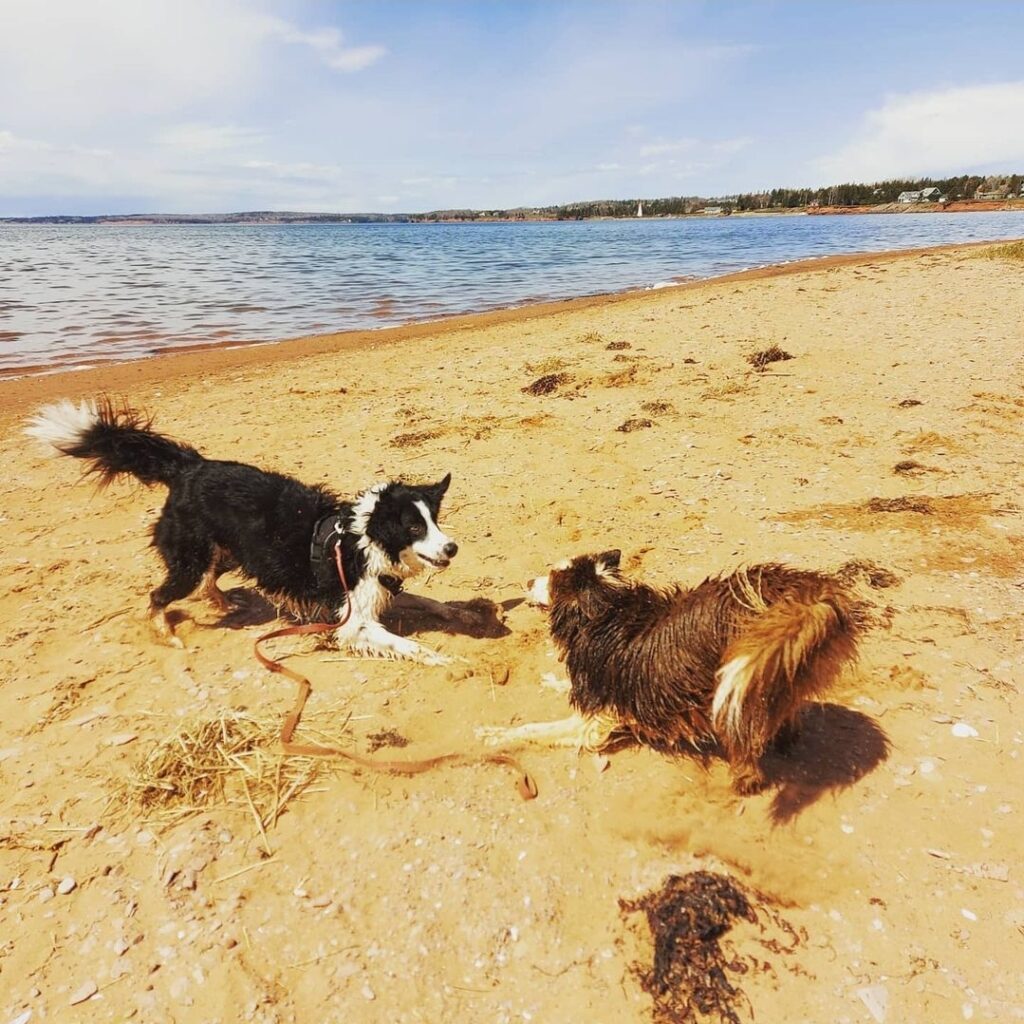
Red Flags
Here is a list of signs to watch for, that would indicate a tense or uncomfortable interaction.
- Stiff Body Language – A rigid, tense posture often signals discomfort or a potential threat.
- High, Stiff Tail Wagging – Unlike a loose, happy wag, a stiff, high tail movement can indicate agitation.
- Intense Staring / Hard Eyes – A fixed, unblinking stare is a warning sign that conflict may arise.
- Ears Pinned Back – Pinned ears can indicate fear or distress
- Growling, Snarling, or Baring Teeth – These are clear signs of discomfort, fear, or aggression and should not be ignored.
- Hackles Raised (Piloerection) – Raised fur along the back and neck suggests arousal; if you notice what’s called ‘’bimodal piloerection’’ (a pattern where the hair at the neck and rump is raised, but smooth along the spine) this indicates fear or anxiety.
- One Dog Freezing in Place, or Trying to Escape – A dog that suddenly stops moving and stiffens is likely uncomfortable and may react negatively. If one dog repeatedly tries to move away and the other keeps following, it’s time to intervene.
- Head-on, Direct Approaches – A straight-line approach with stiff posture can be confrontational.
- Mounting or Excessive Rough Play – Mounting or overly rough behavior, especially if one dog looks stressed or tries to escape, can escalate into conflict.
- One Dog Overwhelming Another – If one dog is relentlessly pursuing another despite avoidance signals, the interaction should be stopped.
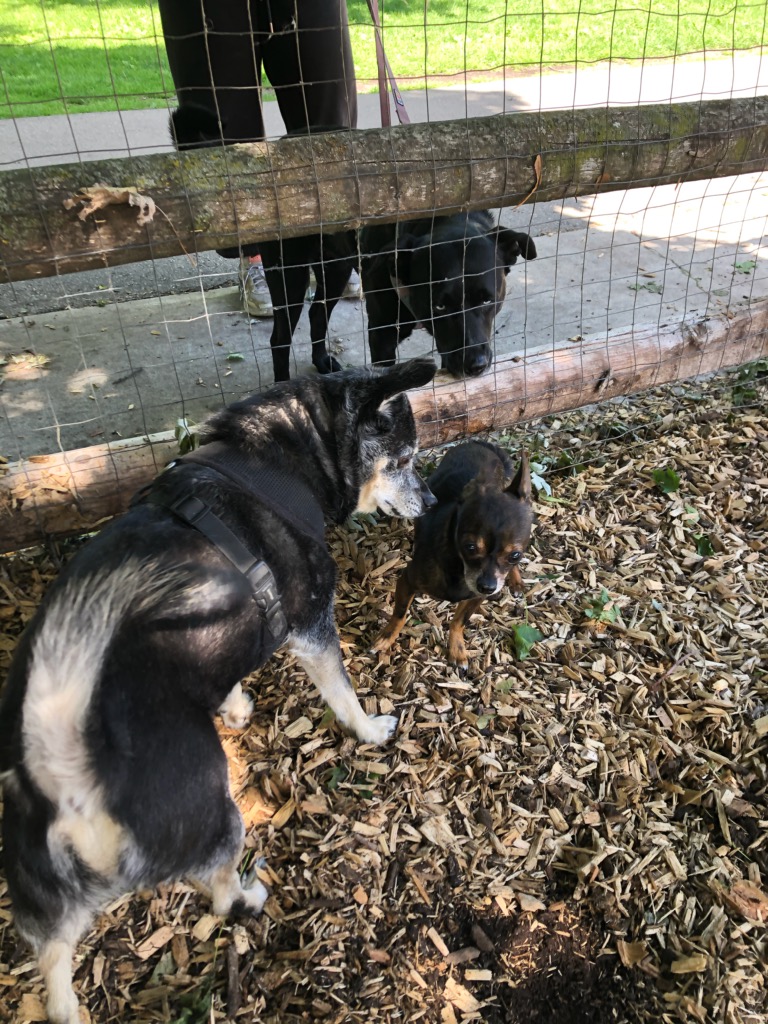
Here’s a canine body-language chart that may be helpful.
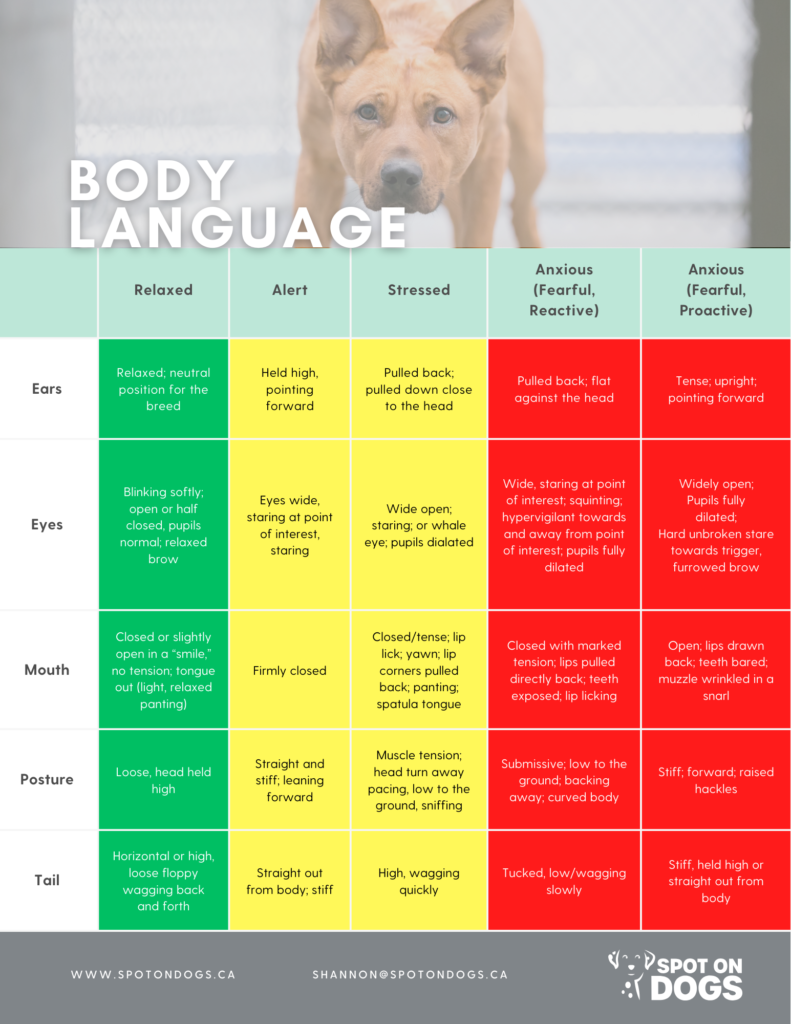
When to Step In
If any of these red flags appear, calmly separate the dogs without yelling or using force. Redirect their attention to something positive, like a high-value treat or a walk in a different direction. If needed, allow the dogs to observe each other from a distance before attempting another introduction, and reinforce them generously for calmly observing.
Tips for Navigating Dog-to-Dog Greetings
- Avoid on-leash greetings if possible: yes, it’s really hard to do, especially if you live in an urban environment! But it can really benefit your dog if you get comfortable saying “no” to on-leash greetings, because it helps your dog learn that when they’re on leash, greetings are a no-go. A helpful tip is to think of something to say ahead of time, which will interrupt an approaching dog-handler duo. Some suggestions include “We need space, we’re training!” “do not approach, please”, or “we can’t say hi today but maybe some other time”
- Only greet if everyone (handlers and dogs) are all on the same page! Take a close look at the body language of your dog and their potential new friend: do they actually want to get to know each other, or are they showing any of the red flags above? Is one (or both) of the dogs Is their handler comfortable and ok with a greeting? (Pro Tip: Always ask the handler BEFORE approaching with your dog.)
- Remember that side approaches are the best way for dogs to interact! Try to guide your dog gently towards the other dog’s rear end so the two dogs can sniff each other.
- If the dogs are on leash, keep the leash nice and loose: try not to put much tension on the leash while your dog greets another dog; we want the greeting to feel comfortable and natural to the dog, not tense and tight.
- Keep the greetings short and sweet: 3-5 seconds max is all that’s needed for an appropriate interaction.
- Reinforce your dog generously for disengaging from the other dog after an interaction (regardless of how it went): we want to teach our dogs that moving away from canine friends and giving them space is highly rewarding!
